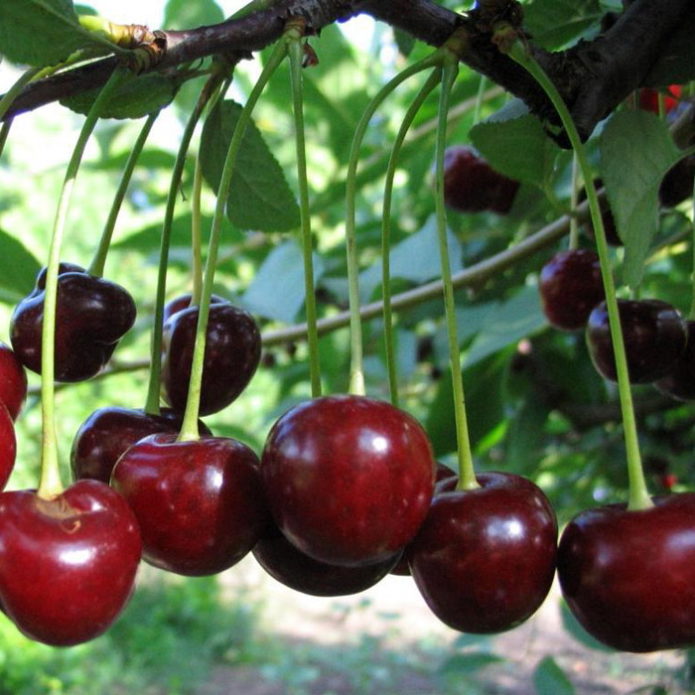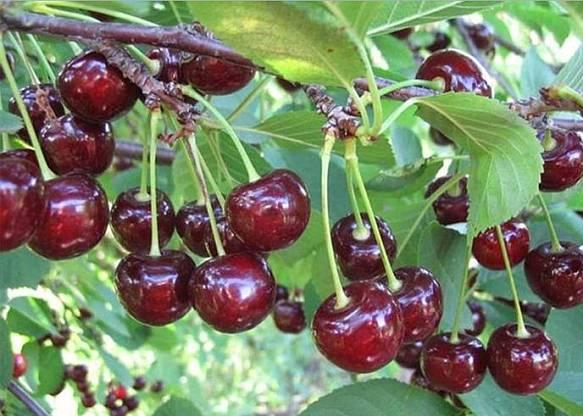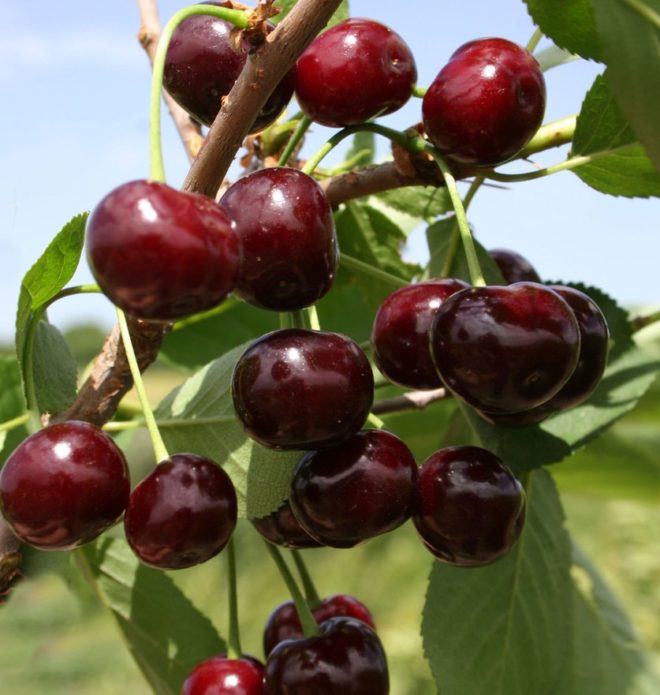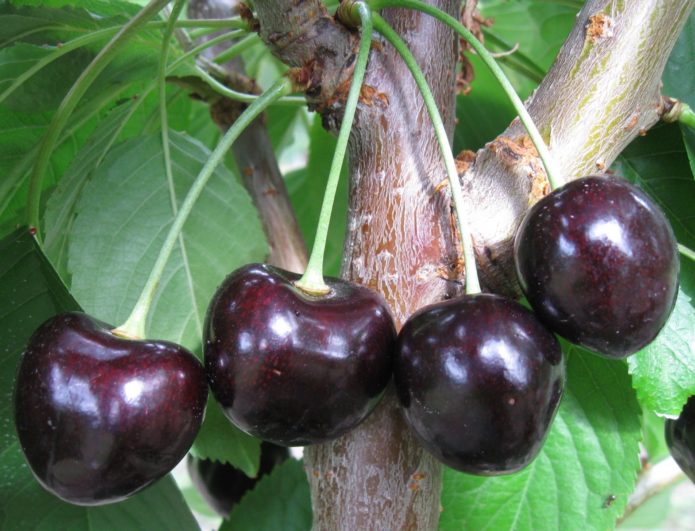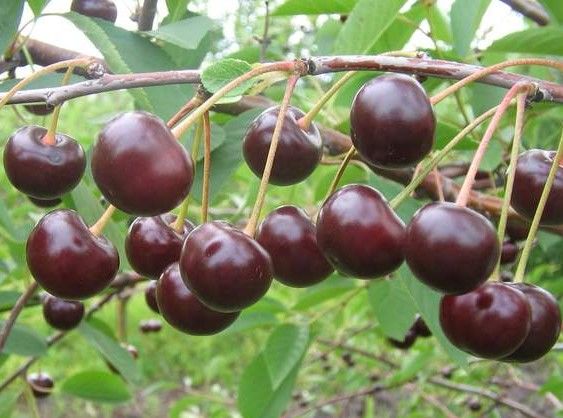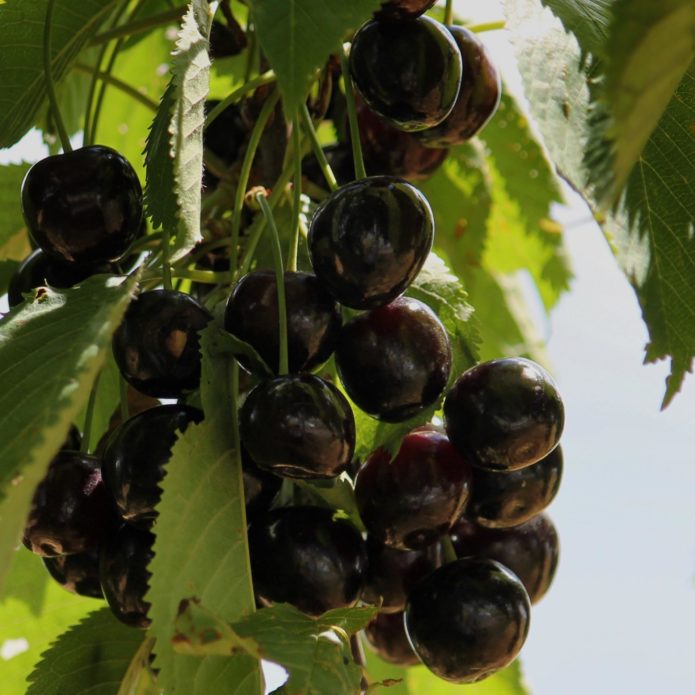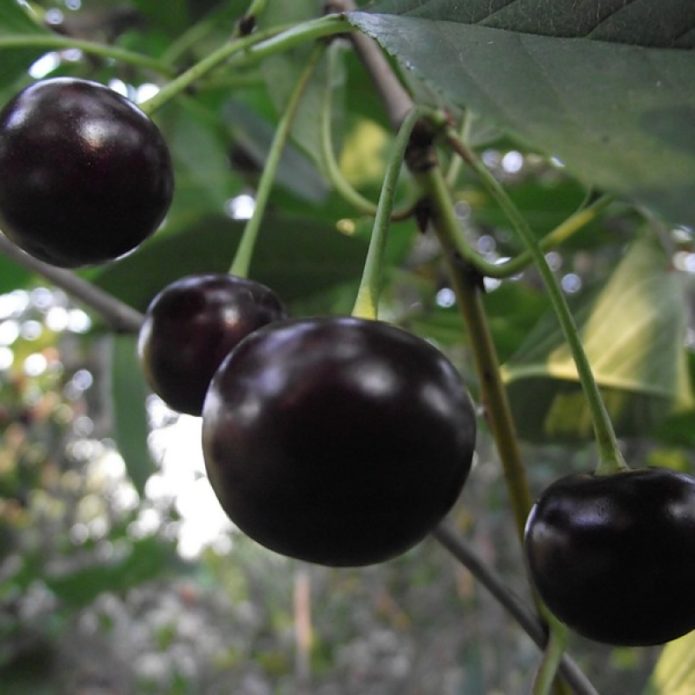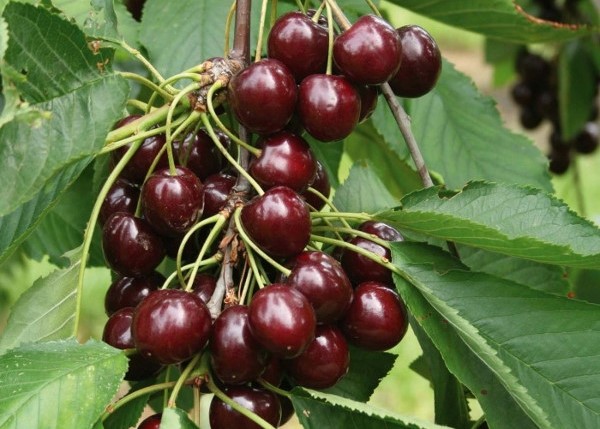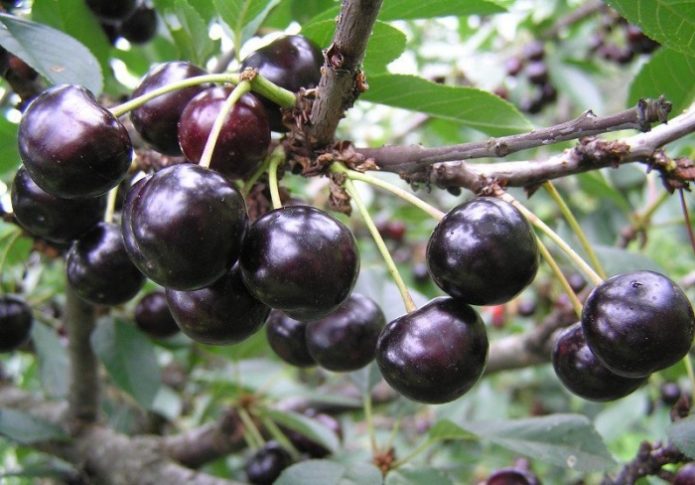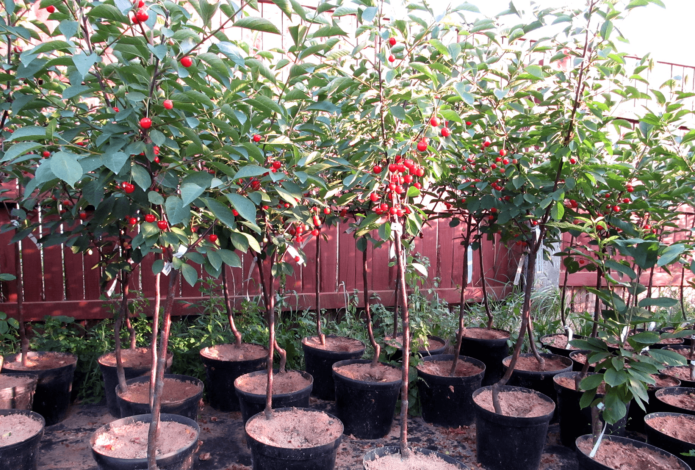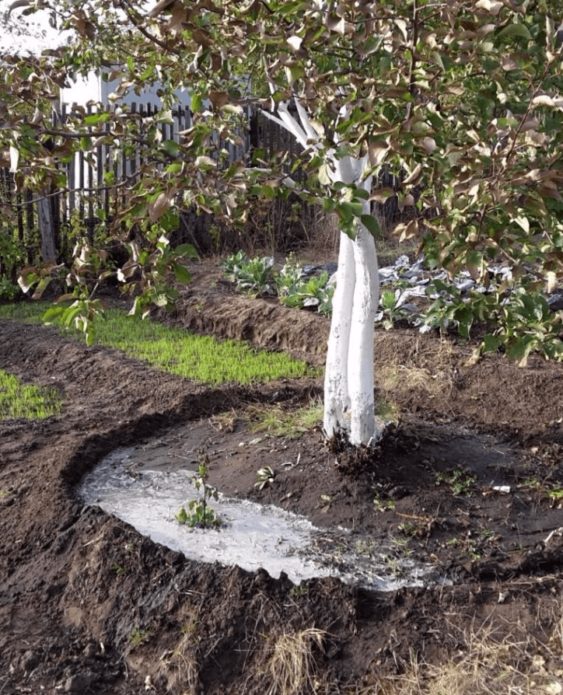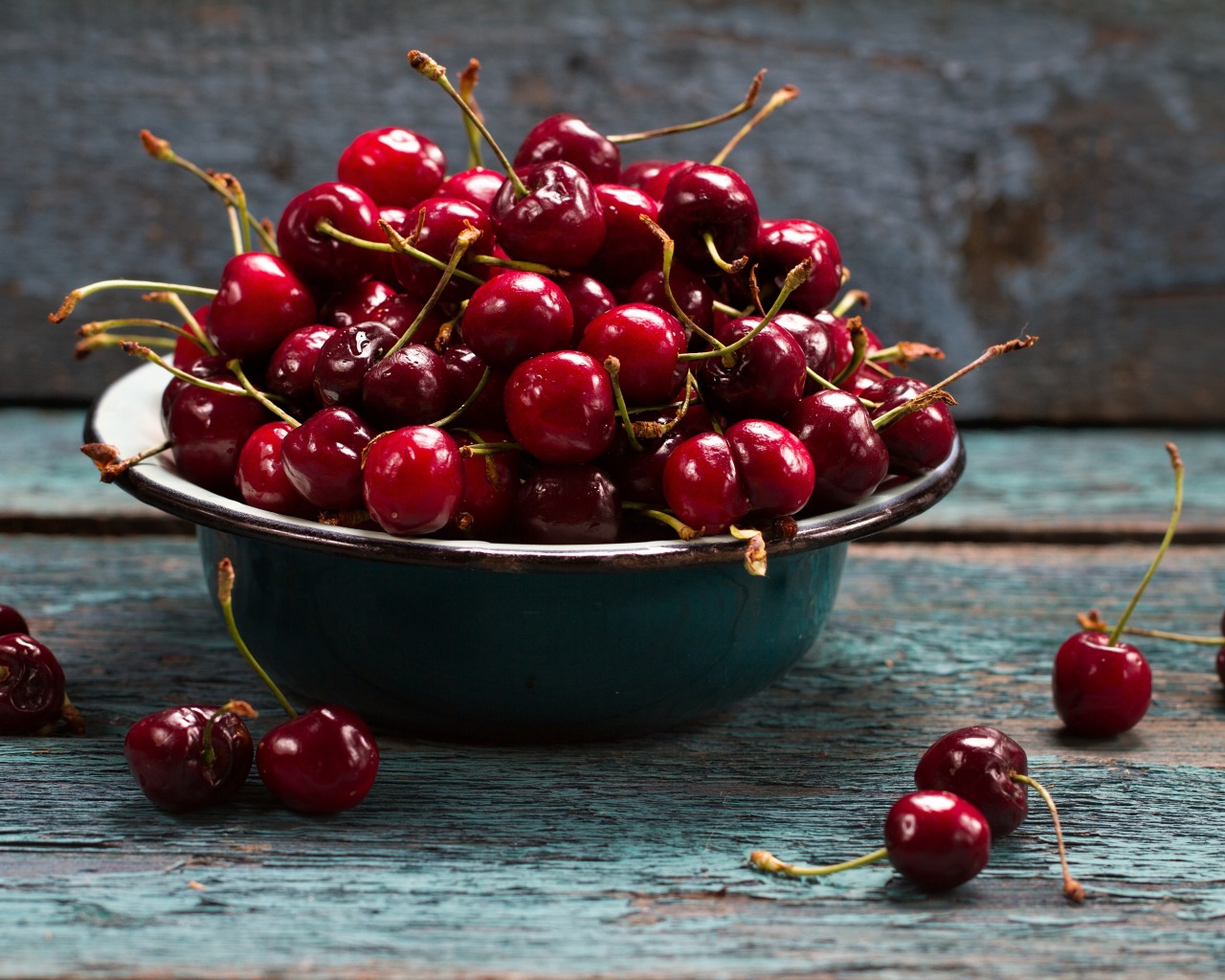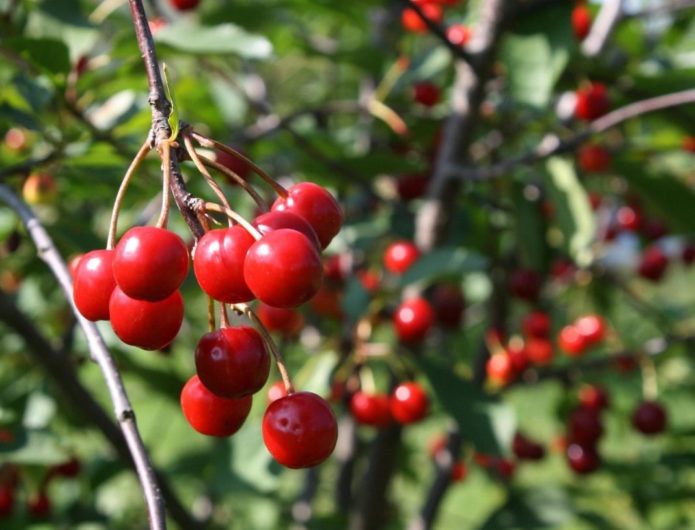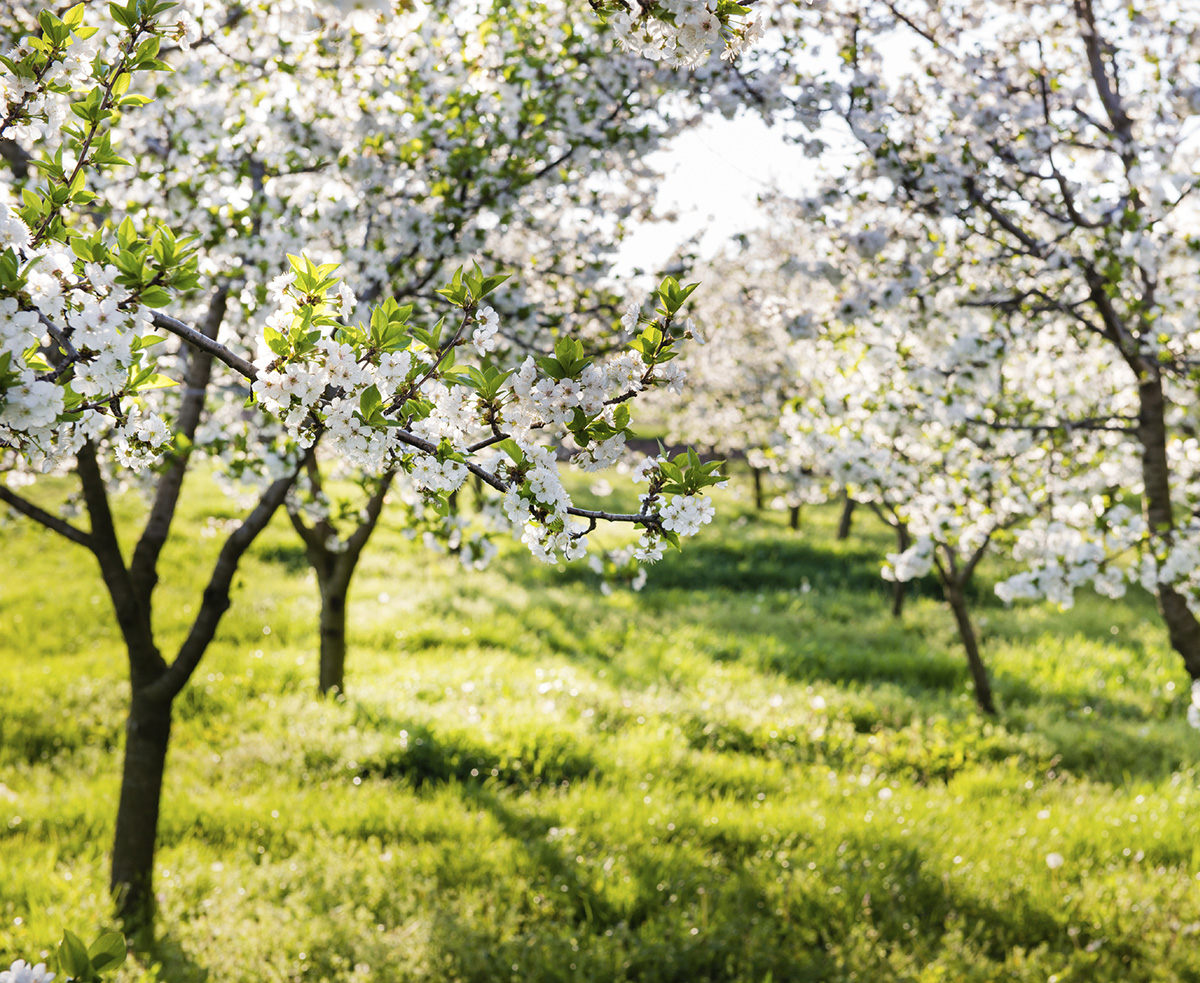There are a lot of cherry varieties. Choosing a culture for the garden, amateurs try to combine in their choice both practical characteristics, and taste, and visual appeal of berries. Can you find the perfect variety starting with the color of the fruit? How to choose the most delicious and fruitful cherry?
Content
Black cherry varieties
According to the color of the fruit, cherries are divided into morel and amorel. Morel (or griot) is a genus of black cherries with dark fruits and brightly colored juice.
The word "morel" came to us from the Italian language and means dark brown color.
These cherries have a pronounced sweet and sour taste. Ripe fruits burst if not harvested on time. They can be picked in advance and will ripen after harvest. Of the black varieties, the most common:
- Vladimirskaya;
- Volochaevka;
- Griot Rossoshansky;
- Zhukovskaya;
- Rossosh black;
- Black large;
- Morel Bryanskaya;
- Chocolate girl;
- Consumer goods Black;
- In memory of Voronchikhina;
- Anthracite.
Cherry Vladimirskaya
The oldest, even the oldest variety. It is loved for its traditional taste. The tree is tall, up to 5 meters. Gives the first harvests 3 years after planting. It is important to understand that Vladimirskaya is a self-infertile variety. This means that for the formation of fruits in the neighborhood, you need to plant cherries that bloom simultaneously with Vladimirskaya. The varieties Turgenevka, Griot Moskovsky, Rastunya, Lyubskaya, Consumer goods Black, Shubinskaya, Lotovaya are suitable for the role of pollinators. Cherry Vladimirskaya is adapted for the conditions of many regions:
- North-West;
- Middle Volga;
- Central;
- Central Black Earth;
- Volgo-Vyatsky.
The variety is winter-hardy, but the cold is destructive for flower buds, therefore, in mid-May, trees must be protected from frost. The berries are harvested in the second half of July. In favorable years, the yield reaches 20-25 kg per tree. Ripe fruits are colored deep black-red with gray dots. The pulp is dense, burgundy, with a bright cherry aroma. The bone is small, easily detachable. The fruits are used to make jams, jams, liqueurs, dried fruits, and are also suitable for quick freezing. Berries do not spoil during transportation and are stored for a long time. With good care, the tree bears fruit for 15 years. Like many old varieties, Vladimirskaya is not immune to fungal diseases, so preventive fungicide treatments are necessary.
Griot Rossoshansky
The variety is characterized by good frost resistance and high winter hardiness. It is resistant to fruit rot, requires protection from coccomycosis. Griot Rossoshanskiy fits the conditions of the North Caucasus and Lower Volga regions. Due to self-fertility, the yield of the variety is annual and stable, it increases in the vicinity of the cherries Rossoshanskaya Black, Vladimirskaya, Zhukovskaya. The berries are ready to harvest at the end of June.The tree is tall, up to 6 m, and gives 16 kg of fruit. The cherries are attractive, medium-sized, very juicy, with dark skin and delicate flesh. The fruit has a pleasant sweet and sour taste with a well-pronounced cherry flavor and aroma. The variety is not transportable and is therefore usually used for processing.
Cherry Zhukovskaya
It attracts with high yield, tree longevity and excellent fruit taste. The variety was zoned in 1947 in the Central, Middle Volga, Lower Volga and Central Black Earth regions. The fruits look very attractive: large, up to 7 g, with brightly colored black pulp and excellent taste. The external qualities and taste of Zhukovskaya cherries are rated five out of five. Fruits ripen together, ripe ones do not crumble. The trees are medium-sized. Zhukovskaya bears fruit from the age of four and, with proper care, lives and gives a rich harvest for 20 years, about 12 kg per tree, can reach 30 kg. Added to the advantages of this variety is coccomycosis resistance. The fruits are highly transportable. The weak points of the variety include insufficient frost resistance of flower buds.
It is important to remember that this is a self-infertile variety. Cherries of the varieties Lyubskaya and Vladimirskaya are planted as pollinators for Zhukovskaya.
Rossoshanskaya Black
Tree up to 4 meters tall. The variety is winter-hardy and frost-resistant, with low sensitivity of flower buds. In the State Register since 1986. Adapted for the North Caucasus, Lower Volga and Central Chernozem regions, but shows its best qualities even in the difficult climatic conditions of the Urals and Western Siberia. Begins to bear fruit at the age of three. After another 3-4 years it comes into full force and gives 15 kg per tree. Under favorable conditions, the yield grows up to 25 kg per tree. Rossoshanskaya Black is a self-fertile variety. With cross-pollination with Zhukovskaya or Vladimirskaya, the yield increases. Rossoshanskaya Black blooms late, and ripens by the end of June. Ripening of fruits is friendly, and ripe berries do not crumble. The cherries are very attractive: large, slightly flattened on the sides, of a beautiful dark color. The pulp of the fruit is fleshy, dark cherry color, with a sweet and sour pleasant taste and a long aftertaste. The most delicious compotes are made from Rossoshanskaya Black. The fruits are well tolerated for long-distance transport. Weak point of the variety: requires additional protection against diseases.
Black large
This variety has many excellent qualities, including frost resistance, winter hardiness, high yield, early fruiting. At the same time, the fruits are large, 6–7 g, of excellent taste.
Important: this is a self-fertile variety, pollinators such as Rossoshanskaya Black, Turgenevka, Griot Ostgeimsky should certainly be planted nearby. The disadvantages of Large Black include instability to disease. At high humidity and low temperatures, it can suffer from moniliosis. Requires protection from coccomycosis.
Morel Bryanskaya
Morel Bryanskaya has many useful qualities that make it very popular. The variety is undersized, so cherries are easy to care for and easy to pick. The yield is high, since the variety is winter-hardy and has immunity against common diseases. It blooms late, therefore it avoids frosts in May. Ripens late. Another great advantage of the variety is its self-fertility. The fruits are tasty, sweet and sour, dark red, small in size. The pulp is juicy, medium density, bright red. Morel Bryansk was zoned for the Central region.
Consumer Black
The variety Consumer goods Black was bred by Michurin himself. This short cherry attracts with its unusual fruit appearance and excellent taste.However, it is gradually being replaced by more promising modern varieties. If we talk about the advantages, one should start with early maturity: the Black Consumer Goods gives its first harvest a year after planting. Ripens in early July. This is a dessert variety. The fruit is black, shiny, as if varnished, heart-shaped, slightly flattened from the sides. The pulp is tender, with a refreshing pleasant sourness. Rich color juice. Fruit weight 4.2 g. Berries on a thin long stalk, which protects them from birds.
Consumer goods Black is a self-fertile variety. For its pollination, you should plant a number of cherries of varieties Zhukovskaya, Lyubskaya, Rastunya or Vladimirskaya. In addition, Consumer Consumer Black does not belong to winter-hardy varieties, so efforts must be made to protect the tree from frost in winter and sudden frosts in May. The yield is moderate.
Memory Voronchikhina
The variety is included in the State Register and is recommended for cultivation in the Central Black Earth Region. Winter hardiness and frost resistance are very good. Medium-sized tree, up to 4 m high. It blooms very early. It is a self-fertile variety. Ripens at the end of June. The average yield is 15 kg per tree, in especially favorable years the tree gives up to 30 kg. The fruits are particularly large in size and have an amazing dark purple color. The cherry tastes sweet, with a slight sourness. The pulp is almost black, dense, the juice is dark red. Weak points of this variety: wet separation of the fruit and therefore low transportability. Requires additional protection against coccomycosis.
Chocolate girl
A wonderful promising variety: it combines compactness, productivity and excellent fruit quality. Added to the advantages are winter hardiness and drought resistance. The tree is not higher than 2.5 m. Average yield is 11 kg. Harvesting from the second half of July. The ripe fruits of Shokoladnitsa are similar to cherries, a dark burgundy color that turns into a rich black. Cherry weight up to 4 g. The stone is easily separated. Cherry connoisseurs love Shokoladnitsa for their delicious sweet and sour fruits with a slight bitterness and cherry flavor. This is a self-fertile variety, but for a higher yield it is advised to plant nearby cherries of the varieties Vladimirskaya, Sklyanka, Turgenevka or sweet cherries. The variety is zoned for the Central region.
Anthracite
The Anthracite variety is included in the State Register and is recommended for growing in the gardens of the Central Region. Anthracite attracts with a wonderful combination of yield, low growth of the tree and its winter hardiness. In addition, Anthracite is drought-resistant. The fruits are heart-shaped and have a beautiful maroon skin. The pulp of the fruit is juicy, dark red, very pleasant to the taste. The fruits are transportable. Anthracite is partially self-fertile; to increase yields, it is recommended to plant next to cherries of the varieties Lyubskaya, Shubinka or Griot Moskovsky.
How to plant black cherries
In regions with frosty winters, cherries should be planted in spring. You need to take care of buying seedlings in the fall, they are immediately added in. Cherry planting holes should also be prepared in the fall. It is important to remember that cherries are not planted singly. Even self-fertile varieties give a greater yield if pollinators grow nearby, so you need to plant 4-5 different varieties that are suitable for flowering times.
How to choose seedlings
It is better to buy planting material in nurseries or a garden center.
Choose only zoned varieties. For planting, you should choose a one-year or two-year seedling. Length - 70-80 cm for a one-year and 100-110 cm for a two-year seedling. The bark should be smooth, without spots, damage, signs of gum flow. You cannot buy seedlings with gray and brown tubercles. There may be pests.Pay attention to the condition of the root system: a healthy tree should have several tap roots no shorter than 30 cm, surrounded by healthy fibrous roots.
Where to plant
The seedling needs an open space. You can't plant cherries in the lowlands: destructive cold air stagnates there. On swampy, sandy or acidic soils, the tree is unlikely to take root. The permissible groundwater level is two meters, not higher. Neighborhood matters too. It is better to plant cherries away from other trees. She especially does not like the close proximity to an apple, pear, raspberry, black currant.
You can plant on a hill by choosing an illuminated and blown area... The scheme for planting cherries on the site depends on the size of the selected varieties. Make sure that tall varieties do not shade undersized ones. Vladimirskaya is planted according to the 4 x 4 scheme, that is, 4 meters between cherries in a row and at least 4 meters between rows. Low-growing varieties can be planted in a 2 x 3 pattern, that is, 2 m between cherries in a row and 3 m between rows. If the soil is heavy, loamy, prepare a hole 80 cm deep and up to a meter in diameter. If the land is fertile, black earth, then a small hole is enough: half a meter deep and 60 cm in diameter.
How to plant a seedling correctly
For the normal development of cherries, it is necessary to choose the right planting time. You need to plant in early spring, until the buds open. The seedlings are taken out of the trench, examined, and the damaged roots are cut off. Place the tree for 6-10 hours in water with Kornevin. Then you need to act like this:
- Drive a one and a half meter peg into the middle of the hole.
- At the bottom, mix equally soil and humus, add a half-liter can of ash.
- Make a small earthen mound.
- Place the seedling on it, gently straightening the roots. It is important that the roots do not bend upwards. Position the seedling so that the root collar rises 5–7 cm above the ground.
- Cover the roots with a layer of fertile soil.
- Water. Half a bucket of water will be enough.
- Tie the cherry to the peg with twine.
- Fill the hole to the top with fertile soil.
- Tamp the soil gently around the trunk.
- Make a hole in the ground around the cherry.
- Water the seedling well.
- Cover the soil around the seedling with humus or compost 7–10 cm thick.
Black cherry care
There is such a pattern: the tastier the fruits, the more care the cherry requires. The basic care for black cherries is the same as for all fruit:
- watering;
- loosening the soil;
- fertilizer;
- protection against diseases and pests;
- pruning.
The first 4 years cherries require special attention, because at this time the root system is formed and the crown grows. The soil around the tree should always be loose. Weeds should not be allowed here. It is important that the root collar is always open.
When the cherry grows, you can plant peas or white clover around it. They enrich the soil with the necessary nitrogen.
Pruning
If the cherry is not cut, its crown thickens, the fruits become smaller, which affects the harvest. Pruning properly will help prevent disease, rejuvenate the tree and increase yields. But this is not an easy and responsible business that requires deep knowledge. Basic pruning rules:
- Pruning is carried out in early spring, a month before bud break.
- Pruning is done not with pruners, but with a sharp garden knife.
- First of all, those branches that grow inside the crown and shade other branches are cut off.
Video: how to prune cherries
Watering
Cherries are quite drought-resistant, but watering is vital for cherries during certain periods. Cherries are abundantly watered (at least 4 buckets per adult tree):
- during the formation of ovaries (approximately in late May - early June);
- when the buds of subsequent flowering are laid (in mid-July);
- before the onset of cold weather (at the beginning of October, to prepare cherries for wintering).
It should be borne in mind that from excess moisture cherry fruits deteriorate. Don't water your cherries too often. And it is necessary to ensure that water does not fall on the root collar.
Top dressing
Cherries begin to be fed when they enter fruiting. With fertilizers, it is important to observe the measure, since overfed cherries tolerate frosty winters worse. Mineral fertilizers are given to mature trees in a year. Once every 3 years in the fall, when digging, 20 kg of compost or manure are introduced. And several times a year, other root dressings are introduced.
Table: root dressings for black cherries
| Top dressing time | Top dressing composition (for 1 tree) |
| After the snow melts | Ash of deciduous trees - 200-300 g for digging a trunk circle |
| Before flowering | Half a bucket of mullein infusion (1 bucket of mullein for 5 buckets of water +1 liter of ash. Let it brew for a week). |
| During the period of filling and ripening of berries | |
| After harvest | Bone meal - 200-300 g. Ash of deciduous trees - 200-300 g. |
| When digging in autumn |
Protection against diseases and pests
If you decide to plant cherries, be prepared for the fact that it will take a lot of effort to prevent and control disease. The most common are moniliosis and coccomycosis. Even if you have chosen disease-resistant varieties, it is necessary to do preventive spraying with fungicides. The first treatment is done with a 3% solution of Bordeaux liquid on young leaves. When the flowers fall off, the cherry is sprayed with the preparation Speed. Again, the Bordeaux liquid is sprayed after harvest.
Pests bring a lot of troubles: aphids, weevils, sawflies and moths. To combat them, you need to dig up tree circles twice a year and keep them free of weeds. In the spring, before sap flow, it is recommended to treat the trunks with Aktellik or Nitrafen.
To protect the bark from rodents in winter, you can wrap tables of cherries with capron in several layers. Some gardeners cover the tree with spruce or juniper branches.
Video: how to care for cherries
Reviews
For example, I really like a cherry variety like Volochaevka, due to the fact that it has rather large cherries, a lot of pulp and it is winter-hardy.
Consumer goods itself is considered very tasty, but you will not find its seedlings, except in old-old gardens ...
Chocolate is a cherry, and there is also the "blood" of cherries. A good variety, if not for susceptibility to coccomycosis and moniliosis. But this is the scourge of almost all varieties. Shokoladnitsa is self-fertile, but it is still better if you plant a pollinator - any at the same time flowering variety.
But, of course, Vladimirskaya is the most delicious cherry variety. Now it is strewn with berries, already dark red, almost black. And on Sunday there was a strong wind and ruffled the cherries. Several berries fell, I picked such berries - they were like sugar and very juicy. Fruit tasting score - 5 in reference books!
Black cherries are beautiful, tasty and fruitful. Choose varieties that are suitable for growing in your area, and remember the rules for caring for these beauties. Good harvests to you!
